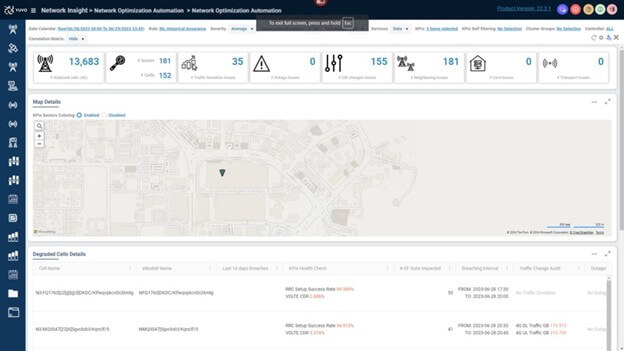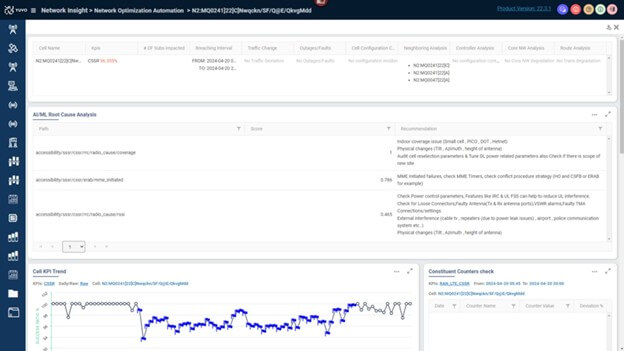In today’s data-intensive telecom landscape, operators face constant fluctuations in key performance indicators (KPIs), alarms, and network failures. Identifying the root causes of these issues is critical to maintaining optimal network performance and ensuring high-quality service. However, this task is often complex due to the multitude of variables involved.
To address this challenge, Yuvo integrates Explainable AI (XAI) techniques into its Automated Root Cause Analysis (RCA) solution. This advanced approach enables telecom operators to not only pinpoint the most probable root causes but also understand why certain patterns emerge, ensuring faster and more accurate resolutions.
The Automated Root Cause Analysis Process
Our RCA solution starts with a machine learning (ML) model trained to understand the dynamics of a specific KPI—whether it be network latency, packet loss, or user throughput. Using historical network data, the model learns how various factors influence KPI behavior. Beyond merely predicting future KPI values, the model’s true strength lies in explaining the underlying causes when a KPI exceeds its normal thresholds.
Once the model is calibrated, we use SHAP (SHapley Additive exPlanations) to analyze how different factors contribute to KPI anomalies, providing operators with clear, actionable insights into the root causes of network issues.
Prediction Model Development
In the telecom sector, KPIs are influenced by many interconnected variables. Factors like user traffic, configuration changes, and environmental conditions all impact performance, but their exact relationships can be difficult to define. This is where AI excels.
At Yuvo, we leverage machine learning to map these complex dependencies, effectively discovering the “formula” that drives KPI behavior. Our prediction process involves ingesting vast amounts of historical and real-time network data from multiple layers, including the control plane, user plane, and network configurations. This data serves as the foundation for training robust models that capture the intricate dynamics of KPIs.
However, AI’s real value goes beyond prediction; it lies in explaining why certain network behaviors occur. This aspect is critical for telecom operators who must trust the AI-driven insights.
Explainable AI: Bridging the Gap Between Data and Decisions
While AI models can detect patterns and predict KPI trends, it’s the explainability of those predictions that transforms data into actionable insights. At Yuvo, transparency is key. Our models not only forecast KPI deviations but also provide logical explanations for the factors driving these anomalies.
This level of explanation is essential for two key reasons:
- Building Trust: Telecom experts—our Subject Matter Experts (SMEs)—need to understand the reasoning behind AI recommendations. XAI reveals the AI model’s “thought process,” aligning its logic with the real-world expertise of SMEs, fostering trust in the system.
- Unlocking New Insights: Often, AI uncovers patterns that even experienced engineers might not anticipate. These “Aha” moments occur when the model reveals hidden correlations, offering fresh perspectives and opening new avenues for network optimization and management.
By providing clear explanations alongside predictions, our solution enhances decision-making, blending AI-driven insights with the deep operational expertise of telecom professionals.
SHAP: Unveiling Key Drivers Behind KPI Anomalies
SHAP is a game-theory-based technique that breaks down AI predictions, offering a transparent view of how each feature influences a KPI. In simple terms, SHAP treats every feature—such as network configuration parameters, user activity, or alarms—as a “player” in a game, distributing the model’s prediction (the “payout”) among these features based on their contribution.
For instance, if there’s a spike in network latency, a SHAP analysis can pinpoint whether the primary driver was a surge in user load, a configuration change, or an alarm trigger. This clear attribution helps operators quickly understand the root causes of anomalies, enabling targeted actions to resolve the issue.
By making AI model outputs interpretable, SHAP enhances trust, allowing operators to confidently address deviations in KPI behavior.
SME-Designed Decision Trees
Identifying the root cause of KPI anomalies is more complex than simply mapping factors to outcomes. Different vendors define counters in varying ways, and KPIs such as reliability, integrity, and availability each require tailored approaches. To address this complexity, Yuvo’s SMEs have encoded their deep telecom knowledge into structured decision trees that guide the RCA process.
Each decision tree organizes network factors (or counters) into specific paths, with each path representing a potential root cause defined by a unique combination of counters. These paths are scored based on the aggregation of individual counters’ SHAP values, allowing the system to rank potential root causes and prioritize the most likely contributors to KPI breaches. This structure generates more accurate and actionable insights, even across different vendors and network elements.
Furthermore, our decision trees are customized for different KPIs. For example, a tree designed for network reliability may focus on hardware and traffic congestion, while a tree for data integrity might emphasize transmission errors or packet loss. This customization ensures our RCA solution is precisely tailored to the needs of each network, enabling operators to act quickly and confidently.
Benefits of Explainable AI in Root Cause Analysis
Yuvo’s use of XAI in RCA delivers several key advantages for telecom operators:
- Enhanced Decision-Making: With clear explanations of how various factors impact KPIs, operators can act decisively, addressing the true drivers of network performance issues.
- Faster Time-to-Resolution: By identifying the root causes of anomalies, operators can directly target issues, reducing downtime and improving overall reliability.
- Improved Trust in AI Systems: XAI provides transparency, ensuring human operators can confidently rely on AI-driven recommendations.
- Scalability: The explainability framework can be applied across multiple KPIs, ensuring consistent, scalable RCA processes across different network segments.
Dashboards for Actionable Insights
Our Network Insight (NI) platform provides operators with interactive dashboards that visualize the results of the Automated Root Cause Analysis process. These dashboards offer both high-level overviews and granular details, allowing operators to quickly interpret insights and take action:

As illustrated in the above, the integration of XAI into Automated Root Cause Analysis plays a crucial role in building the trust telecom operators need to confidently embrace AI-driven solutions. By providing transparent and understandable insights into network anomalies, XAI goes beyond simple predictions, enabling stakeholders to trust and act on AI-driven recommendations.
Yuvo’s solution, backed by mathematically grounded methods and decision trees crafted by telecom experts, offers a clear, data-backed approach to effectively addressing network issues.










